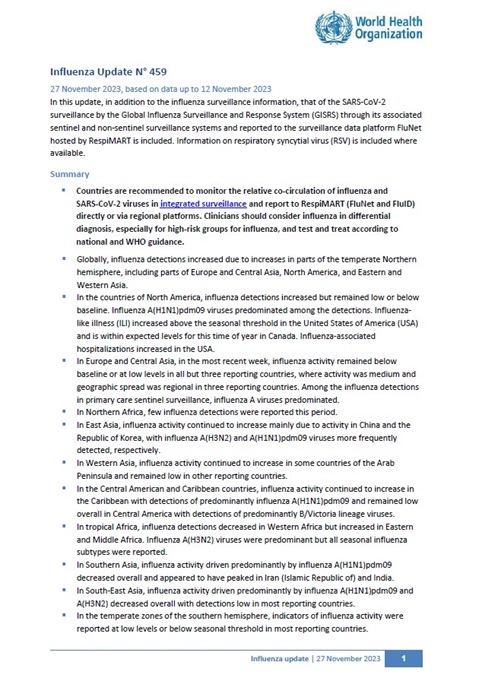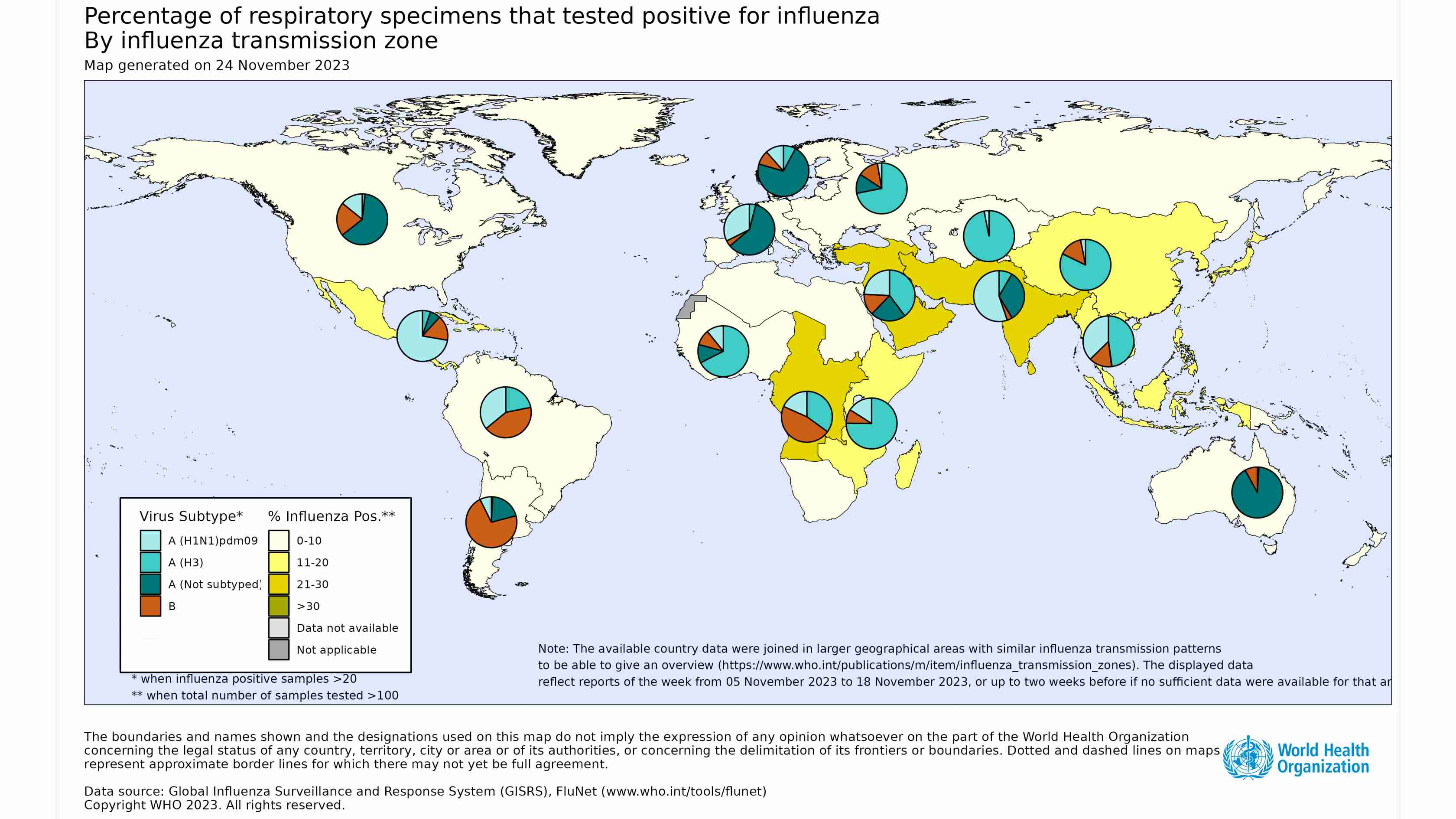Influenza Update N° 459

Overview
27 November 2023, based on data up to 12 November 2023
Information in this report is categorized by influenza transmission zones, which are geographical groups of countries, areas or territories with similar influenza transmission patterns. For more information on influenza transmission zones, see the link below:
Influenza Transmission Zones (pdf, 659kb)
- Globally, influenza detections increased due to increases in parts of the temperate Northern hemisphere, including parts of Europe and Central Asia, North America, and Eastern and Western Asia.
- In the countries of North America, influenza detections increased but remained low or below baseline. Influenza A(H1N1)pdm09 viruses predominated among the detections. Influenza-like illness (ILI) increased above the seasonal threshold in the United States of America (USA) and is within expected levels for this time of year in Canada. Influenza-associated hospitalizations increased in the USA.
- In Europe and Central Asia, in the most recent week, influenza activity remained below baseline or at low levels in all but three reporting countries, where activity was medium and geographic spread was regional in three reporting countries. Among the influenza detections in primary care sentinel surveillance, influenza A viruses predominated.
- In Northern Africa, few influenza detections were reported this period.
- In East Asia, influenza activity continued to increase mainly due to activity in China and the Republic of Korea, with influenza A(H3N2) and A(H1N1)pdm09 viruses more frequently detected, respectively.
- In Western Asia, influenza activity continued to increase in some countries of the Arab Peninsula and remained low in other reporting countries.
- In the Central American and Caribbean countries, influenza activity continued to increase in the Caribbean with detections of predominantly influenza A(H1N1)pdm09 and remained low overall in Central America with detections of predominantly B/Victoria lineage viruses.
- In tropical Africa, influenza detections decreased in Western Africa but increased in Eastern and Middle Africa. Influenza A(H3N2) viruses were predominant but all seasonal influenza subtypes were reported.
- In Southern Asia, influenza activity driven predominantly by influenza A(H1N1)pdm09 decreased overall and appeared to have peaked in Iran (Islamic Republic of) and India.
- In South-East Asia, influenza activity driven predominantly by influenza A(H1N1)pdm09 and A(H3N2) decreased overall with detections low in most reporting countries.
- In the temperate zones of the southern hemisphere, indicators of influenza activity were reported at low levels or below seasonal threshold in most reporting countries.
- National Influenza Centres (NICs) and other national influenza laboratories from 122 countries, areas or territories reported data to FluNet for the period from 30 October 2023 to 12 November 2023 (data as of 24/11/2023 06:34:53 AM UTC). The WHO GISRS laboratories tested more than 431 756 specimens during that period. 25 876 were positive for influenza viruses, of which 21 711 (83.9%) were typed as influenza A and 4165 (16.1%) as influenza B. Of the sub-typed influenza A viruses, 4052 (27.8%) were influenza A(H1N1)pdm09 and 10 533 (72.2%) were influenza A(H3N2). Of the type B viruses for which lineage was determined, all (2073) belonged to the B/Victoria lineage.

- Globally, SARS-CoV-2 positivity from sentinel surveillance decreased to just above 5%. Positivity increased slightly but remained low in the African Region, Eastern Mediterranean and South-East Asia Region. Positivity decreased in the Region of the Americas and the Western Pacific Region. Positivity was highest in the European Region, where it was stable at around 14%. Positivity was around or below 5% in the other regions. SARS-CoV-2 positivity from non-sentinel surveillance increased to around 24% globally.
- In countries with RSV surveillance in place, RSV activity increased in parts of Europe and North America, remained elevated in central America and the Caribbean and was generally low or decreasing elsewhere.
- WHO encourages countries, especially those that have received the multiplex influenza and SARS-CoV-2 reagent kits from GISRS, to conduct integrated surveillance of influenza and SARS-CoV-2 and report epidemiological and laboratory information in a timely manner to established regional and global platforms. The guidance can be found here: https://covid.comesa.int/publications/i/item/WHO-2019-nCoV-integrated_sentinel_surveillance-2022.1.
- NICs and other national influenza laboratories from 81 countries, areas or territories from six WHO regions (African Region: 15; Region of the Americas: 19; Eastern Mediterranean Region: 4; European Region: 32; South-East Asia Region: 5; Western Pacific Region: 6) reported to FluNet from sentinel surveillance sites for time period from 30 October 2023 to 12 October 2023 (data as of 24/11/2023 06:34:53 AM UTC). The WHO GISRS laboratories tested more than 29 811 sentinel specimens during that period and 1679 (5.6%) were positive for SARS-CoV-2. Additionally, more than 25 854 non-sentinel or undefined reporting source samples were tested in the same period and 5317 were positive for SARS-CoV-2. Further details are included at the end of this update.
Source of data
______________________________________________________________________________________________
The Global Influenza Programme monitors influenza activity worldwide and publishes an update every two weeks. The updates are based on available epidemiological and virological data sources, including FluNet (reported by the WHO Global Influenza Surveillance and Response System), FluID (epidemiological data reported by national focal points) hosted by WHO RespiMART platform and influenza and other respiratory virus reports from WHO Regional Offices and Member States. During the COVID-19 pandemic, FluNet has also been receiving updates on testing of samples obtained from routine influenza surveillance systems for SARS-CoV-2. Completeness can vary among updates due to availability and quality of data available at the time when the update is developed.
*It includes data only from countries reporting on positive and negative influenza specimens.
